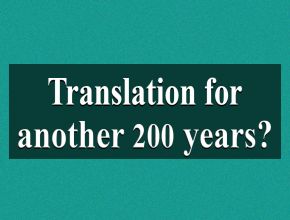Translation for Another 200 Years?

I came to know that Sahitya Akademi has decided to translate ancient Indian texts like Vedas, Upanishads, Bhagavadgita etc into Indian languages and has constituted a committee for this purpose with eminent scholars like Prof Abhiraja Rajendra Mishra, Prof Satyavrata Shastri, Prof Kapil Kapoor, Prof Nanda Kishor Pandey, Prof Uma Vaidya, Prof Harekrishna Satapathy and Sri Janardana Hegde. I have nothing against these great scholars. Each one of them have done the highest and greatest contribution to the nation, Samskrit language and Indian languages and literature in particular. I salute them for their service, tapas and achievements. Here in this short article, I am only trying to convey about one of the roadblocks for the development of Samskrit and the need to have a paradigm shift amongst the lovers of Samskrit and the scholars of Samskrit.
This type of translation from Samskrit to other Indian languages, of the above-mentioned texts in particular, has been going on for the last 200 years and every other translation is said to be more accurate and authentic than the earlier ones! Instead, I am of the opinion that the need of the hour is translation from other Indian languages into Samskrit language in order to contemporize Samskrit literature, to create new content, new literature, new words, new writers, new critics, new journals, new styles and new scholars, to add new dimensions and new courses in Samskrit studies and to bring the Samskrit language and literature out from the current stagnation.
For 200 years, people have been reading translations, not Samskrit. Other languages have thus gotten enriched by such translations, and not Samskrit literature. Samskrit scholars have gotten enriched, not Samskrit language. The publishers got enriched, not the Samskrit language. Those who read translations remained as readers of translations all their life and few learnt Samskrit language. People buy Gita Press’ Bhagavadgita and read the translation, but not the Bhagavadgita, because they never learn the Samskrit language, they have been happy with the easy readymade shortcut called translation! Translated books keep people always dependent on secondary sources. Translated books are the preferred texts in Ayurveda colleges and the referred books for Samskrit papers in BA and MA courses.
Translation from Samskrit language to other languages has become a great obstruction to the development of Samskrit language. For those people who do not know the Samskrit language, it is the easiest way to know the content without the difficulty of learning the language. For young scholars, it is the easiest way to increase their list of publications. For publishers, it is the easiest product to sell and make money. For scholars it fetches both good royalty and plenty of awards. For the politicians it gives them a feeling of satisfaction that they did something for Samskrit. For the Institutional Heads, it pleases their bosses and enhances their achievement list. All are happy. The ecosystem thrives! For how long do we keep doing this business at the cost of Samskrit? For another 200 years?